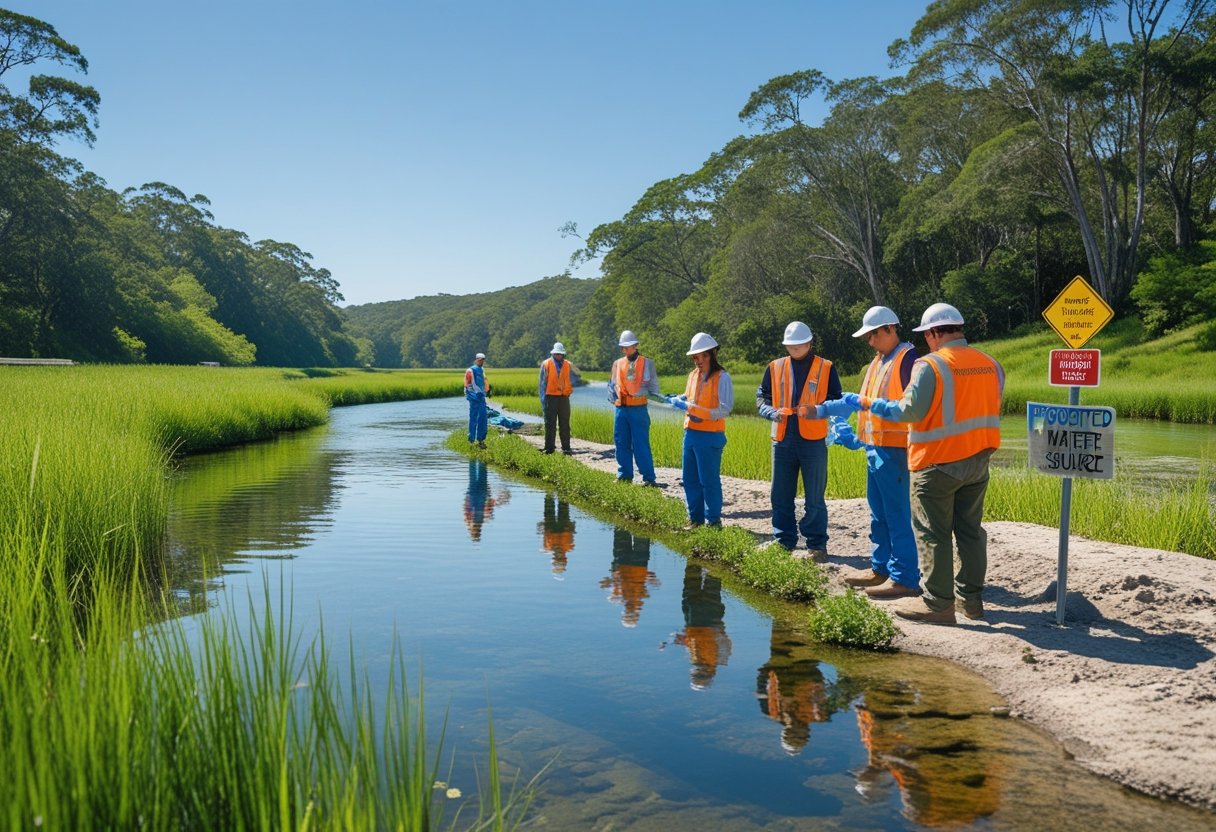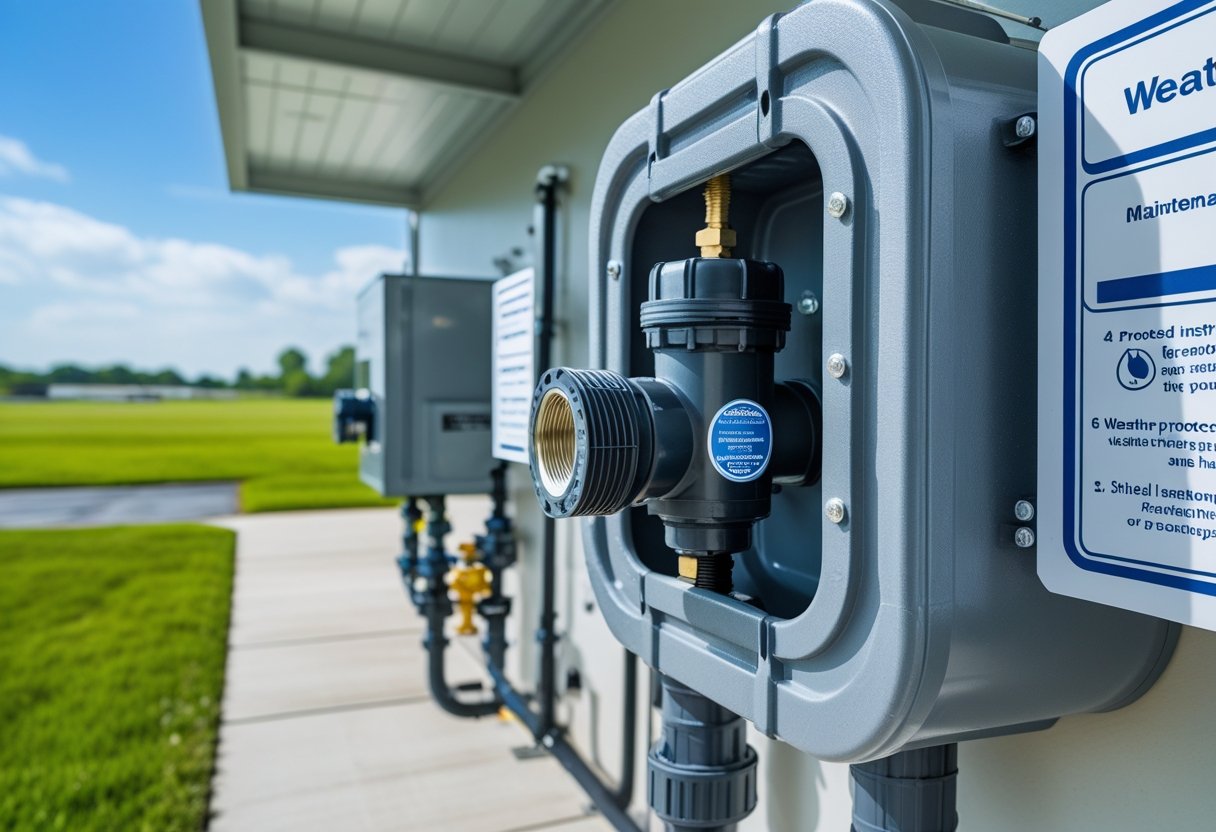Water districts ask for backflow testing reports to keep your drinking water safe from contamination. These reports show your backflow prevention devices are actually working—stopping dirty water from sneaking back into the clean water supply. Without regular testing, harmful stuff could get into your water and put your health—and your neighbors’—at risk.
Certified pros usually handle backflow testing once a year. They know how to check your system quickly and accurately. Staying on top of testing helps you dodge expensive repairs and annoying water shutoffs. Pacific Backflow covers all of San Diego County, offering reliable, responsive testing that keeps you in line with local rules (and honestly, makes the whole thing a lot less stressful).
What Is Backflow and Why It Matters
Backflow is when water flows backward into your clean water supply. That’s bad news because it can pull in contaminants from irrigation or industrial systems. Understanding how backflow happens and what it can do to your water really puts the risks in perspective.
How Backflow Occurs
Backflow usually happens because of changes in water pressure. If the main water line loses pressure, it can suck contaminated water from connected pipes right back into your drinking water. Think water main breaks, big firefighting operations, or just heavy water use—those are the usual suspects.
There are two main types: backpressure and backsiphonage. Backpressure is when a pipe or device has higher pressure than the supply line. Backsiphonage is when a vacuum or negative pressure pulls water backward. Either way, it’s a recipe for contamination.
Risks Associated With Backflow
Backflow lets nasty stuff—chemicals, bacteria, even waste—get into your clean water. This can cause serious health issues and damage your plumbing or appliances. In places with irrigation or industrial systems, the risk jumps way up; pesticides or cleaning fluids could end up in your tap.
Importance of Preventing Contamination
Stopping backflow is how you protect your family’s health and your community’s water. Backflow prevention devices work like one-way doors for water, but they need regular checkups to actually do their job.
Water districts want proof you’re testing these devices every year. Companies like Pacific Backflow can handle the fast testing and paperwork. Keeping your backflow preventer in good shape means you’re doing your part to avoid contamination and follow local rules.
The Role of Water Districts in Public Safety
Water districts are on the front lines of keeping your water safe. They make sure backflow devices work, preventing dirty water from creeping into clean pipes. When everyone follows the testing and maintenance rules, the whole community benefits.
Protecting Community Water Supplies
Districts have to stop contamination before it becomes a bigger problem. Backflow testing helps catch issues early, so harmful stuff doesn’t get a chance to move backward into the clean water supply. If chemicals or bacteria slip in, it could mess up water for a lot of people.
By requiring annual reports, districts can see which devices are working and jump in fast if something needs fixing. This helps prevent expensive and dangerous contamination events.
Testing also makes sure that irrigation systems, businesses, and homes aren’t polluting the shared water. Your district really depends on these regular checks to keep things safe.
Regulatory Responsibilities
Water districts have to enforce backflow testing by law. Most states and cities require yearly reports from certified testers. Skip the test or the paperwork and you could face fines—or even lose your water service.
The rules spell out who can do the tests, how often you need them, and what kind of maintenance is required. Districts keep records and hold you accountable for safe water practices.
By managing testing schedules and repairs, your district protects everyone’s water. They count on professionals like Pacific Backflow to get the job done and file reports, keeping standards high and water safe.
Understanding Backflow Testing Requirements
Backflow testing rules lay out what you need to do to keep your water safe and avoid fines. They cover who must test, how often, and when to submit reports. Knowing these details helps you keep up with your local district’s demands.
Legal Mandates for Backflow Testing
Most water districts legally require backflow testing to protect the public water supply. You have to hire a certified tester to check your backflow prevention device. This confirms your system is stopping dirty water from sneaking into the clean supply.
If you don’t comply, your water could get shut off. The rule applies to homes, businesses, and especially places with irrigation or fire lines. It’s not just a best practice—it’s a legal requirement you have to meet every year.
Frequency and Scheduling of Reports
Usually, you need backflow testing once a year, though some properties might need it more often. Testing takes about 20–30 minutes per device. Afterward, your tester submits results to the local water authority.
Deadlines often fall between spring and early fall. Don’t wait until the last minute—schedule early. Companies like Pacific Backflow handle both the testing and the reporting, so you don’t have to chase paperwork or worry about missing deadlines.
Why Water Districts Require Backflow Testing Reports
Water districts need backflow testing reports to keep water safe, clean, and up to code. Reports help track your backflow prevention devices, spot problems early, and prove you’re following the rules.
Ensuring Compliance With Regulations
Districts require annual reports because the law says so. Most states and cities make properties with backflow devices get them tested every year. These rules are in place to keep contaminated water out of the drinking supply.
When you send in your reports, you’re showing the district your system is up to standard. Ignore it, and you could face penalties or a shutoff. It’s about safety—and avoiding headaches.
Monitoring Water Quality Effectively
Backflow testing reports give districts a way to keep an eye on water quality. If your device is working, it keeps dirty water out of the system. Testing makes sure it’s doing its job all year.
Districts review these reports to spot risks before they turn into real problems. That keeps you, your family, and your neighbors safe from water contamination.
Identifying Potential System Problems
Testing also helps you find issues early. If your device fails or looks worn out, the report spells out what’s wrong.
Catching problems early helps you avoid expensive repairs, weird-tasting water, or sudden service interruptions. Certified testers, like the folks at Pacific Backflow, can help with repairs or replacements if needed. Regular testing just keeps things running smoothly.
What Is Included in a Backflow Testing Report
A backflow testing report gives detailed info on your device’s condition. It shows if your system is working and meeting local rules. Reports include test results, device details, and the documentation you need to prove compliance.
Key Components of the Report
You’ll see facts like the device type, location, and serial number listed right up front. The test results show if your device passed or failed.
If something needs fixing, the report explains the problem and what should be repaired. It also notes the testing date and the certified tester’s name—so you know the check was legit.
There’s info on pressure readings and water flow, too. These numbers show if your system is blocking backflow and protecting your water.
Documentation and Recordkeeping
You have to file backflow testing reports with your local water authority. That’s how you prove you’re following the law and keeping your water safe. You’ll get a copy for your own records as well.
Keep these reports organized—they might come up in future checks or audits. They’re proof you’ve tested regularly and maintained your device.
At Pacific Backflow, we handle report filing for you. After testing, we send everything the district needs, so you don’t have to stress about missing deadlines.
Good recordkeeping helps you avoid fines or water shutoffs. It also makes repairs or replacements easier if you ever need them.
How Property Owners and Businesses Are Impacted
If you own or manage property, keeping up with backflow testing means handling specific responsibilities and steering clear of penalties. Your actions help protect public water and keep your business in good standing with local authorities.
Responsibilities for Compliance
You have to get your backflow prevention device tested each year by a certified pro. The test uses calibrated equipment for accurate results. Afterward, keep detailed records for at least three years. Water districts might ask to see proof your device is working.
If your device fails, you need to fix it right away. Repairs or replacements have to meet district codes. In many places, you must send test results straight to local authorities. Pacific Backflow can handle the testing and reporting for you, making life easier.
Regular maintenance and prompt reporting keep your property safe and up to code.
Consequences of Non-Compliance
Skip your backflow test, and fines can start at $500—sometimes a lot more if you keep ignoring it. Fines can increase every day you delay. Water service might even get cut off until you fix things.
Ignoring the rules also puts public health at risk by allowing possible contamination. Ongoing non-compliance can hurt your reputation and rack up more penalties.
Treat backflow testing as a must-do. Staying on top of it helps you avoid fines and service interruptions, and keeps you in good standing with your local water district.
Benefits of Regular Backflow Testing for the Community
Regular backflow testing keeps your community’s water clean and safe. It checks that the devices stopping dirty water from flowing backward are actually working. This helps prevent health problems and stops contamination from spreading.
Improved Public Health
Testing keeps your drinking water free from harmful stuff. Backflow preventers block chemicals, bacteria, and other contaminants from mixing into clean water. When these devices work, you get safe water for everything—drinking, cooking, cleaning.
If backflow devices fail, contaminants can slip into your water and cause illness. Testing spots problems early, before they impact your health. Cities require these tests for everyone’s safety.
Pacific Backflow provides quick, reliable testing and submits reports for you. It’s one less thing to worry about.
Preventing Widespread Outbreaks
Backflow testing lowers the risk of large-scale contamination. If one building’s device fails, dirty water can move into public pipes and affect lots of homes or businesses.
Regular checks catch faulty devices before they cause trouble. This helps prevent outbreaks of waterborne illness, which can be both dangerous and expensive.
Annual testing follows local laws and keeps everyone safer. Without these rules and regular checks, contamination could spread fast, leading to emergencies and big cleanup costs.
By scheduling tests and repairs with Pacific Backflow, you help protect public health and keep your city’s water quality strong.
Frequently Asked Questions
Backflow testing keeps your water safe by making sure devices actually block dirty water from sneaking back into the clean supply. These tests need to happen regularly, and water districts want reports to show everything’s working as it should.
What is the purpose of conducting backflow prevention tests?
Backflow prevention tests check if your device works right, stopping contaminated water from mixing with clean water. That way, you’re protecting your health and the water everyone else uses, too.
How often should backflow prevention devices be tested?
Most water districts want you to test once a year. Some higher-risk spots might need more frequent checks to keep things extra safe.
What are the consequences of failing to comply with backflow testing regulations?
Skip the required testing and you could lose water service. Worse, you might end up with contaminated water—nobody wants that mess or the expensive fixes that follow.
Can homeowners perform backflow testing themselves, or must it be done by professionals?
You can’t just do it yourself—certified professionals have to handle backflow testing. They’ve got the right tools, and they’ll send the reports to the city for you.
What constitutes a backflow prevention device and how does it work?
A backflow prevention device is basically a valve or mechanical device installed on your water system. It only lets water flow one way, so dirty water can’t sneak back into your clean supply.
Is backflow testing a legal requirement across all states, or does it vary by region?
Backflow testing laws? Well, they’re on the books in most states, but the details really depend on where you live. Local water districts usually decide the specifics—like how often you need to get it done and what exactly they expect.
If you’re in San Diego County and need backflow testing that’s quick and reliable, Pacific Backflow’s a solid choice to help you stay on top of the rules and keep your water safe.











